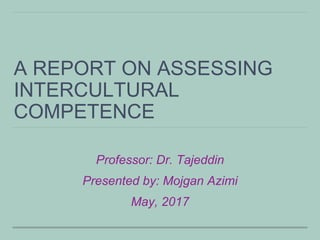
Assessing Intercultural Competence Through Service Learning
- 1. A REPORT ON ASSESSING INTERCULTURAL COMPETENCE Professor: Dr. Tajeddin Presented by: Mojgan Azimi May, 2017
- 3. MOBILITY PROGRAM Student mobility is any opportunity for students to work or study abroad whilst undertaking their degree program.
- 4. SERVICE-LEARNING PROGRAM A teaching and learning strategy that integrates meaningful community service with instruction to enrich the learning experience.
- 5. In 2000, the European Association for International Education highlighted the need for providing to the majority of students who do not participate in mobility programs the knowledge and competences to better understand people from different countries and cultures as well as respecting other human beings in a diverse and multicultural society (Crowther et al., 2000). Domestic service-learning activities.
- 6. PURPOSE The aim of this article is to test, through mixed-methods research, some of the main dimensions of intercultural competence and knowledge highlighted by Deardoff (2006) and by Bennett (2004).
- 7. HYPOTHESIS Students participating in the service learning activities (Nightingale mentoring program )develop more intercultural competences and knowledge than those who do not participate.
- 8. The Nightingale mentoring program has twofold aim: (a) for children and adolescents of migrant background, to make them feel safer at school and get them interested in university studies. (b) for the university mentors, to make them aware of other cultures, religions, and traditions, thus increasing their intercultural competence (Nilsson, 2003, p. 37). AN INTERNATIONALIZATION AT HOME STRATEGY
- 9. The Nightingale program matches a college student with a student from primary or secondary school with immigrant background. They spend 3 hr a week during the academic year (from October to May) doing leisure activities together and develop a personal relationship that strengthens the child’s personal and social confidence. The aim of this course is to enhance students’ ability to effectively approach diversity, to develop flexible mindsets before the worldviews of others, and to promote intercultural dialogues based on respecting and valuing diversity.
- 10. INTERCULTURAL COMPETENCE Intercultural competence is “the ability to think and act in interculturally appropriate ways” (Hammer, Bennett, & Wiseman, 2003, p. 422). It has been highlighted that the foundations of intercultural competence are based on the attitudes of the learner or speaker in relation to other cultures, in how they approach other groups, and in relativizing their worldviews in relation to those of others.
- 11. Attitudes: (a) General openness toward intercultural learning and people from other cultures, (b) curiosity and discovery, and (c) respect for other cultures. • Knowledge and Comprehension: (d) Understanding others’ worldviews, (e) cultural self-awareness, and (f) capacity of self-assessment. • Skills: (g) Listen, observe, and evaluate. • Desired Internal Outcomes: (h) Empathy, (i) ability to adapt to varying intercultural communication and learning styles, and (j) adaptability and adjustment to new cultural environments.1
- 12. METHOD AND DATA 166 participants from Spain (the mentors (n = 95) and the control group (n = 71). Qualitative analysis :10 daily life stories of college students on how they approached intercultural contact, the prejudices, and stereotypes they had and how they changed over time. Quantitative analysis :giving out a questionnaire to both mentor and control groups to observe differences in their worldviews with regard to intercultural sensitivity, competence. Operationalization of 4 dimensions including: Attitude, Knowledge and Comprehension, Skill and Desired Internal outcomes (Empathy, adaptability and adjustment to new cultural environments).1
- 13. RESULT AND DISCUSSION No difference exists between mentors and those who did not participate in the mentoring program in regard to Intercultural Attitudes, Skills and Knowledge, and Comprehension. In the case of Desired Internal Outcomes Students in the control group showed higher levels of Empathy, Flexibility, and Adaptability to diversity than mentors.
- 14. One hypothesis that arises from this outcome is that what students from both groups have in mind when answering the same questions could be different. While students from the control group could express more thoughts based on a desire or on soft experiences they have had in intercultural settings, others could answer based on a better knowledge of themselves with regard to their self-awareness and self-perception in relation to others.
- 15. Qualitative analysis in the pilot interviews with staff that developed the program and the daily life stories with college students showed that mentors tend to be more demanding on themselves and adjust their experiences to reality as opposed to those in the control group when answering surveys and especially quantitative measuring scales. We conclude that learnings intercultural competence and knowledge can be assessed especially using qualitative methods. But we think that quantitative tools could also be considered, in mixed-method assessments.
- 16. Quantitative tools can provide route maps on how the participation of students in extracurricular programs can positively affect students’ attitudes, learning, and competence. A triangulation could help scholars and administrators to better assess how much and how students improve their abilities to relate with others in a context of enriched diversity. The assessment of Intercultural Competence is quite complex and further research is needed to design new tools, rethink existing ones, and find proper methods to carry out triangulations.
- 17. Thank you